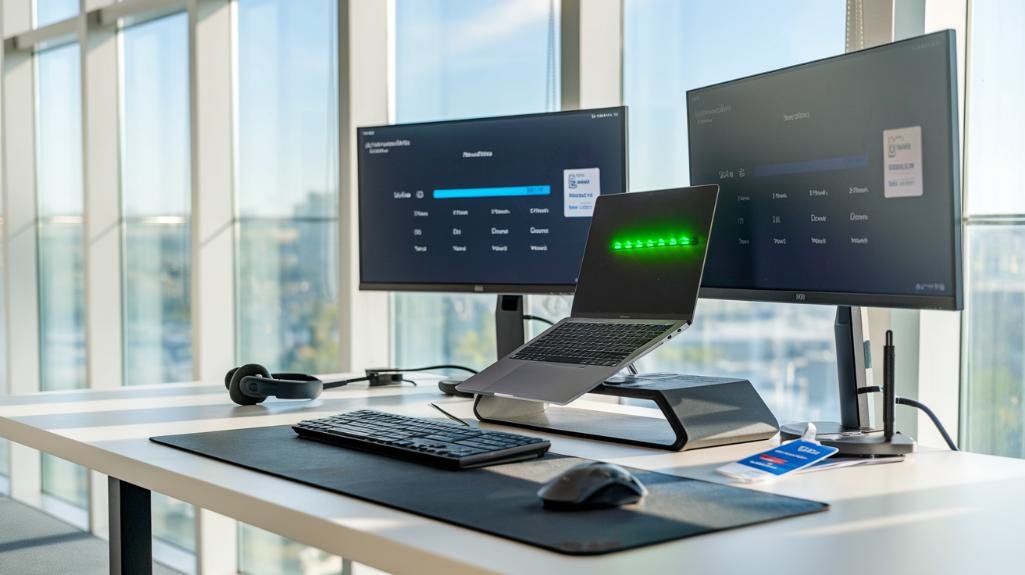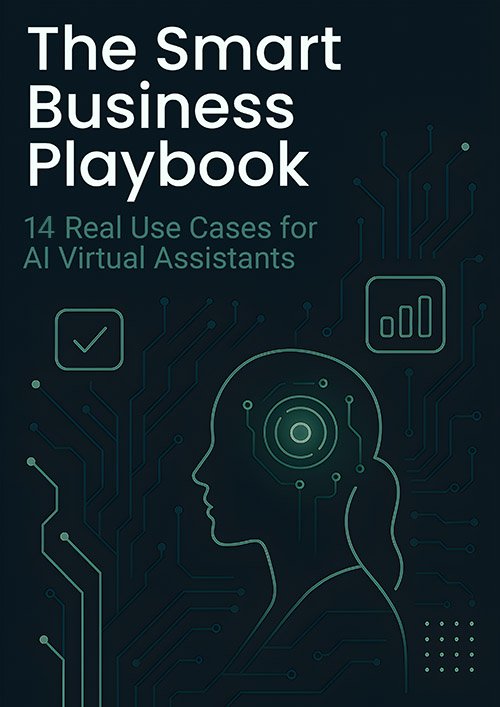To streamline your IT onboarding process, implement automated system access provisioning and standardized hardware distribution workflows. You'll need an extensive pre-arrival checklist covering software permissions, equipment setup, and security protocols. Integrate your HR and IT systems to reduce setup delays by up to 70% while ensuring immediate access to essential tools. Automated identity management and role-based controls will enhance efficiency, maintain compliance, and accelerate your new hire's path to productivity.
Key Takeaways
- Implement automated identity management systems to reduce provisioning time and errors while ensuring proper access rights for new employees.
- Create comprehensive pre-arrival checklists covering hardware, software, and communication tools needed for day-one productivity.
- Establish a centralized system connecting HR and IT departments to coordinate equipment distribution and access setup efficiently.
- Deploy role-based access controls to automatically grant appropriate system permissions based on specific job functions.
- Set up automated task management workflows to track equipment assignments and verify completion of IT setup procedures.
The Critical Role of IT Infrastructure in Modern Onboarding

While traditional onboarding once focused primarily on paperwork and introductions, today's IT infrastructure plays a pivotal role in determining an employee's success from day one. A streamlined onboarding process, supported by robust technology, directly impacts retention rates, with 69% of employees staying longer when they experience efficient onboarding.
Your organization's IT provisioning strategy must prioritize immediate system access and clear communication of technical procedures. By implementing automated HR systems, you'll reduce time spent on administrative tasks and accelerate background checks. This technology-driven approach guarantees new hires can quickly access essential tools and data, maintaining productivity from their first day. When you establish a well-documented IT environment with readily available support, you'll create a positive experience that drives employee engagement and minimizes initial workplace anxiety. Furthermore, adopting solutions like data-driven insights can enhance onboarding effectiveness by analyzing employee retention rates.
Pre-Arrival Technology Preparation and Checklists
Before your new hire's first day, proper technology preparation becomes the cornerstone of successful onboarding.
Setting up technology infrastructure ahead of time lays the essential foundation for seamlessly integrating new team members into your organization.
You'll need to create a thorough checklist that covers all required software access, hardware equipment, and communication tools. Work closely with IT departments to verify timely setup of laptops, monitors, and peripherals.
Automate the provisioning of essential accounts, including project management software and specialized applications.
Provide new hires with early access to training materials and system documentation, enabling them to familiarize themselves with company workflows.
Set up VPN access credentials and prepare step-by-step connection guides to guarantee secure remote connectivity from day one. Additionally, ensure that employee onboarding software is utilized to streamline processes and enhance efficiency.
Automated System Access and Account Provisioning

You'll gain significant efficiency by implementing automated identity management systems that handle user provisioning across your organization's technology stack. Setting up role-based access controls and predefined permission templates guarantees new employees receive appropriate system credentials based on their job functions. Your automated provisioning workflow should incorporate security checkpoints and approval mechanisms to maintain compliance while accelerating account setup. Additionally, ensuring document security compliance as part of the onboarding process can protect sensitive information and streamline HR document management.
Streamlined Identity Management Process
As organizations scale their onboarding processes, implementing a streamlined identity management system becomes essential for efficient employee integration.
You'll find that automated system access and account provisioning can reduce errors while decreasing time-to-productivity by up to 25%.
This guarantees your new hires can access necessary tools from day one.
Account Permissions Best Practices
While establishing streamlined onboarding processes, implementing automated account permissions through role-based access control (RBAC) greatly improves security and operational efficiency. You'll notice faster deployment of system access when you utilize automated workflows, allowing new hires to become productive immediately.
| Process Component | Business Impact |
|---|---|
| Automated Provisioning | Reduces IT team workload |
| Regular Audits | Maintains security integrity |
| RBAC Implementation | Guarantees proper access levels |
To maintain robust security, you must conduct regular permission audits and adjust access rights based on role changes. Your automated account provisioning system should align with established onboarding processes, creating a seamless experience for both IT teams and new employees. This approach considerably reduces manual intervention while guaranteeing all necessary security protocols remain intact.
Essential Software and Hardware Distribution Strategies
Implementing an efficient software and hardware distribution strategy stands at the core of successful employee onboarding.
You'll need to leverage a centralized online system that coordinates between HR and IT departments, reducing setup delays by up to 30%. By automating the hardware distribution process, you'll guarantee new hires receive their essential software and equipment on day one.
- Deploy automated task management workflows to track equipment assignments
- Implement standardized IT setup checklists for consistent onboarding experience
- Configure automated emails for software access credentials
- Create hardware procurement triggers based on hire dates
- Establish pre-arrival testing protocols for all equipment
This systematic approach drives a 70% improvement in onboarding experience while enabling new hires to familiarize themselves with workplace tools before their start date. Additionally, utilizing digital platforms can enhance organization and speed of the onboarding process for both new hires and HR teams.
Your centralized system will streamline the entire process, guaranteeing standardized deployment across all departments.
Security Protocols and Compliance During IT Setup

Robust security protocols during IT setup form the cornerstone of your organization's data protection strategy.
You'll need to implement automated identity verification systems to protect sensitive company data and comply with regulations like GDPR and HIPAA, which carry substantial penalties for violations.
During the onboarding process, establish clear data access guidelines and guarantee new hires understand their responsibilities.
Proper onboarding protocols with clear data access rules ensure employees know their security obligations from day one.
You'll minimize accidental breaches by integrating thorough training sessions that address common security risks and compliance requirements. Since human error accounts for 90% of data breaches, your focus should be on prevention through education.
Track and document all security measures implemented during IT setup to maintain compliance and demonstrate due diligence. Additionally, understanding HR confidentiality laws is crucial for safeguarding employee privacy and ensuring compliance with data protection regulations.
This systematic approach protects your organization from costly cyber attacks that could otherwise threaten your business's survival.
Measuring IT Onboarding Efficiency and Success Metrics
You'll gain valuable insights by tracking key performance indicators like hardware setup times, access provisioning completion rates, and first-month support ticket volumes through automated data collection systems.
Your organization's IT onboarding metrics should align with specific targets, such as achieving 24-hour setup completion and maintaining 90% new hire satisfaction rates.
Key Performance Indicators Analysis
Measuring IT onboarding efficiency through well-defined Key Performance Indicators (KPIs) enables organizations to optimize their setup processes and enhance new hire productivity.
You'll need to track specific metrics to identify bottlenecks in onboarding and implement streamlined processes for continuous improvement.
- Time to provision equipment and software access
- First-day setup completion rates across all systems
- Percentage of new hires reporting successful access to required tools
- Average time taken to complete IT setup tasks by category
- Employee engagement scores correlated with onboarding efficiency
Automated Data Collection Methods
To streamline the IT onboarding process effectively, implementing automated data collection methods proves essential for tracking key metrics and success indicators.
You'll find that HR tech systems can reduce administrative workload by up to 30% while enabling real-time analysis of onboarding metrics and task completion rates.
Frequently Asked Questions
How to Streamline Employee Onboarding Process?
Deploy onboarding software with digital checklists to automate workflows, set up user accounts and IT equipment, prepare welcome kits, coordinate employee training, enable remote access, and establish feedback loops.
What Is the IT System Onboarding Process?
You'll follow an IT onboarding checklist covering employee access management, software installations, hardware setup, IT policies, communication tools, cybersecurity training, technical support resources, and performance tracking systems.
What Are the 4 C's of Employee Onboarding?
Your onboarding program's 4 C's – Compliance, Clarification, Culture, and Connection – establish performance expectations, drive employee engagement, facilitate cultural assimilation, and strengthen team dynamics through mentorship initiatives.
What Are the 5 C's of Onboarding?
You'll navigate onboarding through the five C's: Compliance for policies, Clarification for role expectations, Culture for values integration, Connection for team relationships, and Checkback for continuous feedback mechanisms.


